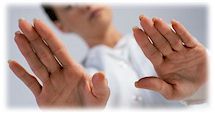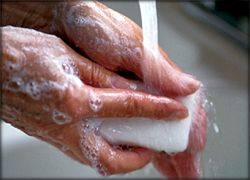Personal Hygiene-Lesson
One

Instructional Goals
By following thin lessen, learners will be able to be
more familiar with personal hygiene practice. Leaner must spent around 2 hours to go through each
topics and sub topics. Thereafter, it is recommended that all
learners will
visit some of the links that have given and gain information about personal
hygiene.
Course Structure
Objectives
At the end of this lesson, learners should have a clear
understanding of:
- what is mean by Personal hygiene
- the important of personal hygiene
- About germs and their effect
- How to wash-out germs from your hands
- When and how to wash hands
- Other important personal hygiene practices.
Assessment
At the end of the course learners must attempt the multiple choice questions
exam on-line. Results will be prompt immediately and it is expected that
learners will score over 50% to meet the restaurant food safety requirements.
Introduction
Good personal hygiene is essential for food safety. Disease-causing bacteria
may be present on the skin and in the nose of healthy people. All food handlers
must therefore maintain a high standard of personal hygiene and cleanliness in
order to avoid transferring pathogens to foods.
At the end of this course, employees must be more familiar with personal
hygiene.
Hygiene
The microbes on our food that can cause food poisoning
are usually controlled by heating (cooking) and/or chilling (refrigerating) our
food, but given the chance they can easily be spread around the kitchen - via
our hands, chopping boards, cloths, knives and other utensils. If they are
allowed to cross-contaminate other foods - especially cooked and ready-to-eat
foods - they can make us ill. Good kitchen hygiene and good personal hygiene are
important to help control the spread of harmful germs.
Germs on hands
The number of germs on fingertips doubles after using the toilet. Yet up to
half of all men and a quarter of women fail to wash their hands after they've
been to the toilet! How to Wash Hands.
We all think we know how to wash out hands but many of us don't do it
properly

How to wash hand
- Always use warm water. It's better to wet hands before applying soap as
this prevents irritation.
- Rub hands together vigorously for about 15 seconds, making sure both sides
of the hands are washed thoroughly, around the thumbs, between each finger
and around and under the nails.
- Then, rinse with clean water.
- Germs spread more easily if hands are wet so dry them thoroughly. Use a
clean dry towel, paper towel or air dryer; it doesn't matter which.
Hands must be washed before:
- Working
- Handling food and utensils
Hands must be washed after:
- Using the toilet
- Handling raw food
- Coughing, sneezing, eating, drinking or smoking
- Licking fingers
- Every break
- Touching pimples or sores
- Handling waste
- Carrying out cleaning duties
- Changing soiled clothes
- Touching ears, nose, hair, mouth, or other bare body parts
- Handling animals
- Any other unhygienic practice
Checklist for Personal Hygiene Practices of Food-handlers
- Uniforms, aprons (or clothes) should be clean at the beginning of a work
shift
- Wear a hair restraint (hat or hairnet)
- Keep fingernails short and clean
- Avoid touching nose, mouth, hair and skin during food preparation
- Do not smoke in food premises
- Do not cough or sneeze directly onto food. Wash hands after coughing or
sneezing
- Wash your hands after blowing your nose
- Avoid wearing jewelers while handling and preparing food
- Avoid using strong perfumes/after shaves
- Do not wear uniforms or aprons outside the food preparation area
- Cover all wounds or cuts on hands or arms completely with
bright-colored
waterproof wound strip
- Wear disposable gloves if there is a wound on the hand. Change both gloves
and wound strip regularly
- Food handlers to be free from any illnesses such as gastro or the flu
- Cease work and report to the manager while ill
More Information on food safety
Test your self here!!!!
 Back to top
Back to top


